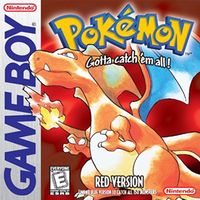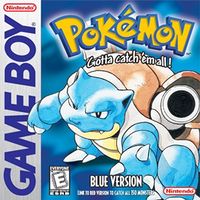| Site Notice |
|---|
|
We have a limited coverage policy. Please check our coverage page to see which articles are allowed. |
Pokémon Red and Blue Versions
| This article is a short summary of Pokémon Red and Blue Versions. Bulbapedia features a more in-depth article. |
| Pokémon Red Version | ||||||||||||||
| ||||||||||||||
| Pokémon Blue Version | ||||||||||||||
| ||||||||||||||
| ||||||||||||||
| ||||||||||||||
| ||||||||||||||
|

|
This article may be improved with a cleanup. You can help NintendoWiki by improving readability, reorganising content, or adding any existing dedicated templates. |
Pokémon Red Version and Pokémon Blue Version are the first games in the Pokémon series to be released outside of Japan for the Game Boy. While the games are based on the original Pokémon Red and Green Versions released in Japan, they use the improved code of the Japanese Pokémon Blue Version. They were released in North America on September 28, 1998.
The games were later remade for the Game Boy Advance as Pokémon FireRed and LeafGreen.
Contents
Blurb
"You've finally been granted your Pokémon trainer's license. Now, it's time to head out to become the world's greatest Pokémon trainer. It's going to take all you've got to collect 150 Pokémon in this enormous world. Catch and train monsters like the shockingly-cute Pikachu. Face off against Blastoise's torrential water cannons. Stand strong when facing Pidgeot's stormy Gust. Trade with friends and watch your Pokémon evolve. Important--no single Pokémon can win it all. Can you develop the ultimate Pokémon strategy to defeat the eight GYM Leaders and become the greatest Pokémon Master of all time?"
Story
Like all main series Pokémon games, Red and Blue features a young boy on his journey to defeat the eight gym leaders and the Elite Four in order to become a master. The player starts in Pallet Town where they will meet Professor Oak, who lets the player choose from one of three starter Pokémon. Later Pokémon will be available for capture later on the journey.
Gameplay
The Pokémon games are different from most RPGs by the fact that the player must catch their "party" to battle other Pokémon. The player may run into other Trainers who will demand to fight. Winning fights against other trainers will give the player money. In a couple of towns, there are gyms where the player must defeat the gym leaders. Defeating a gym leader will earn the player a badge. There are eight badges in all. Earning all eight will unlock access to the Elite Four. Defeating the Elite Four and the Champion will have the player become the Champion and win the game.
Pokémon can also be traded with other players using a Game Link. Both versions has exclusive Pokémon only obtainable in that version, and must be traded to get in the other game.
Development
In development
Debugging
See [1]
- Unused default names used for debugging the program appear; いしはら/Ishihara for the protagonist (named after Tsunekazu Ishihara)) and やまぐち/Yamaguchi for the rival, possibly named after Wataru Yamaguchi. In Pokémon Blue (Japanese), they were changed to ゲーフリ (Game Freak) and クリチャ (Creatures), respectively. In Pokémon Yellow, they were changed to ゲーフリ1 for the protagonist and the rival name was unchanged. [1]
After release
Localisation
- Pokémon Red and Blue Versions are localisations of the Japanese Pokémon Red and Green Versions, and the (originally promotional) Pokémon Blue. A localisation of the Green version was never officially released (though pirates have abused this fact to create bootleg English versions of Green), nor the exact versions translated (available Pokémon to find in the wild, as well as in-game trades differ).
Debugging
- In the English versions, NINTEN and SONY are unused debugging default names for the player character and the rival character respectively, and are loaded into the memory before the new game sequence. They were possibly intended for debugging, because there is a leftover debug mode allowing the player to skip the new game sequence and encounters by holding down the B-Button. NINTEN and SONY are references to Nintendo and Sony, considered as a 'rival' of sorts to Nintendo. It has also been mentioned NINTEN is the name of the protagonist from EarthBound Beginnings; a game developed by Ape, who later changed their name to Creatures, Inc.; developers who assisted with Pokémon and its marketing; however, in the Japanese versions the names are different and refer to important development personnel/companies. It is not clear whether NINTEN and SONY were introduced solely by translator Nob Ogasawara (otherwise known as Doug Dinsdale), or if the original developers were aware of it.
Legacy
References
- Developers of the core Pokémon games, Game Freak included references the following references to other media:
- Text "A game with MARIO wearing a bucket on his head!" for viewing the SNES in the Mimic Girl's house of Saffron City; referencing Game Freak's other game Mario & Wario.
- Default names for protagonist Red in the Japanese version include Satoshi and Shigeru, a reference to founder of Game Freak Satoshi Tajiri and Shigeru Miyamoto.
- The Japanese name of the ship S.S. Anne is "Saint Anne" (サント・アンヌ号). This is the same name as the computer which created Pulseman (another game by Game Freak).
Technical details
|
Release data
Demo versions
A possible unidentified demo according to a historical K-Mart video game sale video was made. As Pidgey is referred to as "PIDGE", this may have been from the period localizations of the Japanese Pokémon species names into English were different and simpler (such as Lapras being referred to as "Ness").
Retail versions
| Title | Cover art | Platform | Release date(s) | Notes |
|---|---|---|---|---|
| Pokémon Red Version Pokémon Blue Version (Game Pak) |
Game Boy | 1998/1999 | The Game Pak versions include functionality with Pokémon Stadium, Super Game Boy, Super Game Boy 2. Unlike the eventual Virtual Console releases which handled things differently, linking with different languages is allowed (but reportedly not advised by Nintendo), though the game does not read the player's parties correctly at all (sometimes unless the player has a specific party and makes a specially prepared trade, causing Red/Green save data to corrupt).
After this game was localized from Red and Green Versions and Japanese Blue into English, new glitches would make it into the game such as the "left-facing shore tile glitch" to encounter Pokémon previously stored in the grass encounter table/old man demonstration player's name buffer (common exploits include the "old man"/'MissingNo.' glitch and fighting Safari Zone Pokémon outside of the Safari Zone), or text specific errors such as a character discussing a Raichu that "evolved" after an in-game trade (this was caused because this in-game trade originally featured a different Pokémon; a Kadabra, which does evolve after trade). The other localizations would have text errors like this too, such as incorrect translation of "hooked" (as in a Pokémon encountered using a fishing rod) into "malvado" ('wicked') in the Spanish version. The Italian and Spanish versions in fact partially fixed the left-facing shore tile glitch by checking if the player is Surfing across them, and if so, returning a Tentacool. However, the base glitch is still there (although MissingNo. and unrelated glitch Pokémon function differently between different the languages and often versions) if the player uses one of the other glitches which still exist in the games to walk on the left-facing shore tile instead of Surfing. Furthermore, although encountering MissingNo. and other Pokédex number 000 Pokémon (well-known for their item duplication effect) was always possible with the "Trainer escape glitch", a new glitch called the "grass/rock Surfing glitch" was introduced in the Italian and Spanish versions, in which players would encounter a Trainer before using the "Surf down glitch" to Surf on a grass or cave tile with normal encounters but no water encounters to find Pokémon based on the previous Trainer's data; as the water and Trainer buffer pointers, like grass/old man name are also the same (as long as the player changes their direction but does not make a step).
| |
| Pokémon Red Version Pokémon Blue Version |
Virtual Console (Nintendo 3DS) | 2016 | Emulated ports for Nintendo 3DS. Pokémon Stadium support is no longer possible. Communication between these games as well as Yellow including trading and battling, is possible with wireless communications. It is possible to trade with Virtual Console Gold, Silver and Crystal wirelessly using those game's Time Capsule feature. The region must be the same (though specifics with the Australia, Oceania, Taiwan, Hong Kong releases which may be exceptions are not clear), or this will not work (the games will not allow the link to occur, as opposed to initiating the battle/trade but the game incorrectly handling the parties).
Division of player money after black out is now calculated in a different way, but changes to how much money the player is left only apply with invalid money values caused by glitches. The emulator used also is not perfect, treating invalid opcodes like "nop" instructions, meaning a few glitches act differently (though well known ones like "old man glitch", MissingNo., "Trainer escape glitch"/'Mew glitch' work the same).
|
Reception
Pokémon Red and Blue have sold over 15 million copies, 10.4 million copies in Japan and 8.6 million copies in North America.
The game was critically acclaimed, earning a 10 out of 10 on IGN. Nintendo Power listed the game as #3 on the Top Ten Best Gameboy Games.
External links
Trivia
- Tsunekazu Ishihara's favorite Pokémon is Exeggutor because he always used it while debugging the program].[3]
References
| This article is a stub. You can help NintendoWiki by expanding it. |


